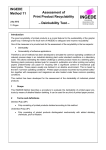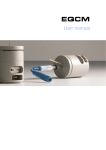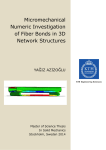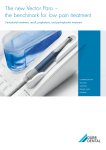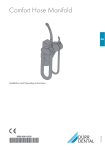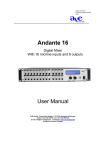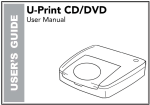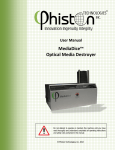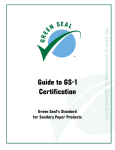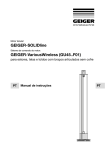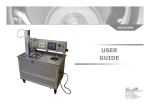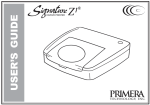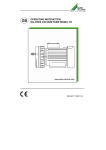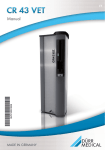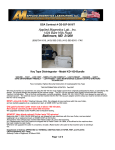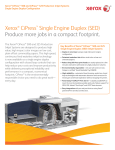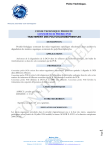Download INGEDE Method 11p Assessment of Print Product Recyclability
Transcript
INGEDE Method 11p December 2009 Assessment of Print Product Recyclability – Deinkability Test – 11 Pages Introduction A good recyclability of printed products is a crucial feature for the sustainability of the graphic paper loop. It belongs to the focal work of INGEDE to safeguard and improve recyclability. One of the measures is to provide tools for the assessment of the recyclability in the two aspects: • Deinkability • Screenability of adhesive applications. Therefore a set of methods has been developed to simulate the common operating conditions of relevant process steps in an industrial deinking plant under standard conditions in a laboratory scale. This allows to estimate the relative challenge a printed product means to a deinking plant. Deinking plants producing deinked pulp for newsprint, publication and other printing & writing papers predominantly use recovered paper with a significant content of mechanical pulp based grades. These papers usually are deinked in an alkaline environment. This is meant by the term “common operating conditions”. Printed paper products recovered by household collection together with newspapers and magazines are also treated under these common operating conditions. This method has been developed for the assessment of the deinkability of individual printed products. Note: This version of INGEDE Method 11 is provisional (“p”). The reason for this is described in Annex C. 1 Scope This INGEDE Method describes a procedure to evaluate the deinkability of printed paper products by means of alkaline flotation deinking. It can be used for any kind of printed paper product. 2 Terms and definitions Deinked Pulp (DP): • Pulp consisting of printed products deinked according to this method. Undeinked Pulp (UP): • Pulp consisting of printed products disintegrated mechanically with added deinking chemicals, prior to flotation. INGEDE Method 11p Page 2 Assessment of Print Product Recyclability – Deinkability Test – 3 Principle Flotation is the most widely used technology for ink removal in the paper recycling process. This INGEDE Method in a laboratory scale defines the essential steps of the flotation deinking process: pulping and flotation. In order to simulate the average age of paper recovered from households, an accelerated aging step is part of the procedure. Special care was taken to define a procedure without the need to test unprinted paper. The whole laboratory procedure is shown in Figure 3. The deinkability is assessed by three quality parameters of the deinked pulp and two process parameters. Quality parameters: • • • luminosity colour shade dirt specks (in two different size categories). Process parameters: • • ink elimination filtrate darkening. INGEDE Method 11p Page 3 Assessment of Print Product Recyclability – Deinkability Test – 4 Equipment and auxiliaries 4.1 Equipment • Warming cabinet with free or forced ventilation or with air turbulence according to ISO 287. • Analytical balance up to 1 000 g with an accuracy of at least 0,001 g • Analytical balance up to 3 000 g with an accuracy of at least 0,1 g • Hobart pulper N 50, available from Hobart GmbH. Use the type of stirrer and a comparable cover, shown in the following figures. Additionally, it is possible to install a revolution counter, which stops the device automatically. Figure 1: Stirrer for the Hobart pulper Figure 2: Cover for the Hobart pulper • Standard disintegrator according to ISO 5263. For larger pulp volumes the standard vessel can be used, for small volumes (12 g oven dry) an accessory cylindrical vessel is necessary for disintegration • Temperature-controlled water bath • Heating plate equipped with magnetic stirrer, or commercial-grade hot-water heater • Laboratory flotation cell (references: PTS cell, Voith Delta 25™) • Plastic scraper (in case of PTS cell) • Beakers • Muffle furnace which can be adjusted to an incineration temperature of 525 °C • pH measuring system with an accuracy of 0,1 points. If different equipment is used, this has to be mentioned in the test report. 4.2 Chemicals • Sodium hydroxide (NaOH), pro analysis, CAS # 1310-73-2 • Sodium silicate 1,3–1,4 g/cm³ (38–40 °Bé) • Hydrogen peroxide (H2O2), e.g. 35 % • Oleic acid (C18H34O2), extra pure, CAS # 112-80-1, e.g. Merck Article No. 1.00471 • Calcium chloride dihydrate (CaCl2 · 2 H2O), CAS # 10035-04-8 INGEDE Method 11p Page 4 Assessment of Print Product Recyclability – Deinkability Test – 5 Procedure Print product Oven: t = 72 h T = 60 °C Ageing Hobart pulper: c = 15 % t = 20 min T = 45 °C m = 200 g Speed = 2 Defibration Water bath: c=5% t = 60 min T = 45 °C Storage Desintegrator: c=4% t = 1 min Homogenisation Flotation cell: Voith Delta as example c = 0,8 % t = 12 min T = 45 °C m = 180 g Deinking recipe: 0,6 % NaOH 1,8 % Sodium silicate 0,7 % H2O2 0,8 % Oleic acid (optional) Undeinked pulp: 2 Filter pads Flotation deinked pulp: 2 Filter pads 2 Handsheets 2 Membrane filters Figure 3: Flow chart test procedure assessment of deinkability INGEDE Method 11p Page 5 Assessment of Print Product Recyclability – Deinkability Test – 5.1 Sampling The printed samples used in the tests must not be split up. The minimum amount of each printed sample is 250 g oven-dry. 5.2 Identification Each print product is designated by its title, publishing house, issue date, product category, printing method and paper grade, if available. Weigh the complete printed product. After weighing, remove any inserts and non-paper components from the printed product to determine their share in the total mass of the product. 5.3 Separation of adhesive applications To allow the sticky-forming potential of the printed product to be assessed independently, separate all evident adhesive applications from the paper, mark them according to their use, and store them separately. Note: Glued backs of magazines or catalogues shall be separated by means of a saw. Please refer to INGEDE Method 12. 5.4 Accelerated ageing Place the samples in a warming cabinet for accelerated ageing at 60±3 °C for 72 hours. If no accelerated ageing is applied, this has to be noted in the test report. Accelerated ageing of the samples is necessary because the storage of the recovered papers can influence their deinkability. These accelerated ageing conditions correspond to 3–6 months of natural ageing. 5.5 Breaking up of samples The thermally aged samples are torn into pieces of about 2x2 cm² and acclimatised. A part of the acclimatised samples is used to determine the moisture content according to ISO 287 with at least one sample of about 50 g minimum. Based on the obtained results, calculate the appropriate air-dry weight of the samples which corresponds to the oven-dry weight prescribed. 5.6 Weighing the samples After homogenising the samples by hand, weigh out samples of 200 g oven-dry. 5.7 Preparation of dilution water During laboratory treatment of the printed products (see 5.9 to 5.12), use only water which has been treated to obtain the prescribed hardness values. To obtain the desired water hardness, add calcium chloride dihydrate (CaCl2 · 2 H2O) in deionised water until the concentration of calcium ions has reached 3,21 mmol/l, equivalent to 472 mg/l. This is equivalent to 128 mg Ca2+/l. If tap water is used, this shall be mentioned in the test report indicating the respective hardness. INGEDE Method 11p Page 6 Assessment of Print Product Recyclability – Deinkability Test – During sample preparation, a constant temperature of 45 °C should be maintained (see Figure 3). The dilution water should therefore be stored in a water bath whose temperature can be controlled accordingly. It is also possible to heat part of the dilution water to a considerably higher temperature by means of a hot-water heater, and successively add cold dilution water until the desired temperature has been reached. It is not advisable to separately heat the individual stock solutions (dilution water, chemical stock solution, peroxide solution). 5.8 Preparation and dosing of chemicals The standard formulation is as follows: Chemical Dosage (related to oven-dry paper) Sodium hydroxide 0,6 % (100 %)* Sodium silicate 1,8 % (1,3–1,4 g/cm3)* Hydrogen peroxide 0,7 % (100 %) Oleic acid 0,8 % (extra pure) * Only if the pH is either too low or too high after pulping or if it is too low before flotation, the dosages of sodium hydroxide and possibly also of sodium silicate have to be adapted (see 5.9 and 5.11). Make sure that the chemicals are dosed with a relative tolerance not exceeding ±1 %. It is useful to prepare a total amount of 2 l stock solution which will be sufficient for 5 tests. Dissolve 6 g sodium hydroxide in deionised water, heat slightly to approx. 60 °C and proceed by adding 8 g oleic acid. Stir until the solution is clear, then add 18 g sodium silicate and fill up with deionised water to 2 litres. The formation of soap reduces the alkalinity. 0,114 % sodium hydroxide are needed to neutralise the oleic acid. In addition, prepare the hydrogen peroxide solution for each test, using deionised cold water. 5.9 Disintegration Fill the Hobart pulper with the prescribed sample quantity (200 g oven-dry). Take 400 ml of chemicals solution and fill up to a total volume of 1233 ml with appropriately heated dilution water in order to achieve a consistency of 15 %). Add this deinking liquor into the vessel and run the Hobart pulper for some seconds. Then stop it, brush down any scrap of paper from the vessel wall. Repeat this step as often as necessary. After the first stop, add the peroxide solution (100 ml). Immediately after, disintegrate the stock for 20 min at approx. 45 °C, using rotor speed 2. To maintain a constant temperature and avoid splashing losses, cover the vessel during disintegration, for example with a suitably sized, tight-fitting plastic lid (see Figure 2). At the end of pulping, measure the pH. Measurement see Annex A. The pH has to be 9,5 ± 0,5. If the pH is beyond this range, the sample has to be discarded and the test repeated with an adapted dosage of sodium hydroxide. In case of too low pH after pulping the dosage of sodium hydroxide has to be increased. In case of too high pH, both sodium hydroxide and sodium silicate have to be reduced by the same ratio. The minimum dosage of sodium hydroxide is 0,2 %. INGEDE Method 11p Page 7 Assessment of Print Product Recyclability – Deinkability Test – Measurement of the pH at the surface of the print product can be made in order to get an idea whether a low pH after pulping has to be expected. See Annex B. 5.10 Storage The amount of disintegrated stock needed for the subsequent treatment steps depends on the quantities required for the final handsheet and filter pad formation (see 5.13). Stock quantities of 12 g oven-dry undeinked (UP) and approx. 15 g oven-dry deinked pulp (DP) are needed in minimum. Stock losses will vary depending on the print products used and can amount up to 50 % during flotation. Store the amount of stock required for subsequent treatment for 60 min in a water bath at 45 °C (consistency 5 %). Measure the pH before and after the storage time. Measurement see Annex A. 5.11 Homogenisation and dilution Use a disintegrator if necessary (optional treatment) to disintegrate fibre bundles immediately after storage (consistency 4 %). Disintegrate the stock at a rotor speed of 3000 min-1 for one minute. After storage or homogenisation respectively, the stock samples must be diluted with 45 °C warm water to terminate any chemical reaction before the treatment continues. Use tap water for the UP sample. For the pulp sample to be deinked, use water that has been brought to a temperature of 45 °C and the desired hardness. The consistency after this dilution should be around 1 %; it can be the consistency required for flotation. Measure the pH. At flotation consistency it should be equal or higher than 7,5, provided that the defined range of the pH after pulping is met. If the pH before flotation is below 7,5, discard the sample and repeat the test with a higher dosage of sodium hydroxide. Start the flotation before preparing the UP specimens. 5.12 Flotation Heat up the cell with hot water if the cell has big metal parts. After some minutes pour out the heating water and fill in first some of the prepared dilution water of 45 °C to prevent the “concentrated” pulp from staying in dead corners later. Add the disintegrated and diluted sample into the flotation cell. Fill up with dilution water, and proceed as the instructions of the flotation cell describes. The starting point for the flotation time is when the air supply is started. The process time is set in the following instructions for the recommended flotation cells. For other cells, the process should run until the status of hyper-flotation is reached. 5.12.1 PTS flotation cell Use the following settings for flotation: air supply rate 60 l/h, stirrer speed (in suspension) 1200 min-1, flotation period 10 min, suspension temperature approx. 45 °C, consistency approx. 0,8 %. During the entire flotation process, use the scraper to remove the froth without stock, if possible. Collect the skimmed-off flotation rejects in a tank. Continually add dilution water to compensate INGEDE Method 11p Page 8 Assessment of Print Product Recyclability – Deinkability Test – for the drainage, keeping the suspension level constantly up at the edge of the overflow for the duration of the flotation. After a flotation period of 10 min switch off the air supply and the stirrer. Use dilution water to bring down any rejects from the overflow into the collecting tank and then dewater the froth. Determine the amount of the overflow oven-dry according to ISO 4119 and use this amount to calculate the flotation yield. 5.12.2 Voith Delta 25TM The air supply has to be set to approx. 7 l/min. Use the supplier’s calibration sheet to find the corresponding point on the scale. The other parameters are: flotation period 12 min, suspension temperature approx. 45 °C, consistency approx. 0,8 % at the beginning with 180 g oven-dry pulp. During the flotation process add the necessary amount of 45 °C warm water several times in order to maintain the level of the aerated suspension in the cell. In case of low foaming tendency, increase the level in order to guarantee the overflow of foam. After the flotation period switch off the air supply. Use dilution water to bring down any rejects from the overflow into the collecting tank, and then dewater the froth. Determine the amount of the overflow oven-dry according to ISO 4119, and use this amount to calculate the flotation yield. 5.12.3 Other laboratory flotation cells Use flotation parameters and conditions similar to the standard conditions applied during the laboratory treatment of deinked recycled pulps. The flotation should run until the status of hyper-flotation is reached. Set the flotation time in order to get maximum luminosity and ink elimination. 5.13 Specimen preparation For undeinked pulp two filter pads and for deinked pulp two filter pads and two laboratory handsheets are required to permit an optical evaluation. In addition, two membrane filter specimens are prepared from the filter pad filtrate of the deinked pulp so as to be able to assess filtrate quality. INGEDE Method 1 is used to prepare the specimens. 5.14 Analysis The following optical characteristics of air conditioned filter pads, laboratory sheets and filtrate filters are determined using INGEDE Method 2. • Luminosity Y of deinked pulp in accordance with DIN 6174. • L*, a*, b* colour coefficients of deinked pulp in accordance with ISO 5631. • Ink elimination IE700 and/or IEERIC (see INGEDE Method 2 chapter 5.2.8 to 5.2.12). • Filtrate Darkening ∆Y of deinked pulp (see INGEDE Method 2 chapter 5.2.13). • Dirt particle area A of deinked pulp (see INGEDE Method 2 chapter 5.3). • Ash content of undeinked and deinked pulp in accordance with ISO 1762 (use filter pads for this determination). INGEDE Method 11p Page 9 Assessment of Print Product Recyclability – Deinkability Test – The reflectance factor R∞ of filter pads made of deinked and undeinked pulp is determined at a wavelength of 700 nm by means of INGEDE Method 2 so as to be able to determine ink elimination (IE700). Additionally a dirt area analysis is performed on laboratory sheets obtained from deinked pulp by means of a scanner based image analysis system. 6 Report The following should be recorded in the test report: • Identification of print product as to name, publishing company, date of issue, product category, print process and paper quality. • Mass-related proportion of supplements and non-paper material in %. • Number and type of adhesive applications. • pH after pulping, before and after storage and before flotation. • Chemical dosage for pulping. • Ash content of undeinked and deinked pulp. • Luminosity Y of deinked pulp. • L*, a* and b* of deinked pulp. • Ink elimination IE700 in %, R∞,UP, R∞,DP at 700 nm. • Alternatively to IE700, the ink elimination using ERIC values (IEERIC) may be determined. • Filtrate darkening ∆Y of the deinked pulp sample filtrate. • Dirt particle area of deinked pulp in mm²/m² in two categories with the dirt particle area > 50 µm and the dirt particle area > 250 µm. • Flotation yield in %. Deviations from the conditions stipulated for this test method, if applicable (e.g. pulping device, specification of the laboratory flotation cell, conditions of flotation). Any further optical characteristics of undeinked and deinked pulp yielded as well as their respective filtrate quality may also be noted in the test report. 7 References 7.1 Cited Standards and methods • DIN 5033 – Colorimetry (in German) • DIN 6174 – Colorimetric evaluation of colour coordinates and colour differences according to the approximately uniform CIELAB colour space (in German) • DIN 53 145-1 – Testing of paper and board – Basic parameter for determination of reflectance factor – Part 1: Measurements made on non-fluorescent specimens (in German) INGEDE Method 11p Page 10 Assessment of Print Product Recyclability – Deinkability Test – • DIN 54 500 – Testing of paper – Determination of the desity-related light-scattering and absorption coefficients of paper and fibre materials (in German) • INGEDE Method 1 – Test sheet preparation of pulps and filtrates from deinking processes • INGEDE Method 2 – Measurement of optical characteristics of pulps and filtrates from deinking processes • INGEDE Method 12 – Assessment of the Recyclability of Printed Paper Products – Testing of the Fragmentation Behaviour of Adhesive Applications • ISO 287 – Paper and board - Determination of moisture content of a lot - Oven-drying method • ISO 1762 – Paper, board and pulps — Determination of residue (ash) on ignition at 525 °C • ISO 4119 – Pulps – Determination of stock concentration • ISO 5263 – Pulps – Laboratory wet disintegration • ISO 5269-2 – Pulp – Preparation of laboratory sheets for physical testing. Part 2: RapidKöthen method • ISO 5631 – Paper and board - Determination of colour by diffuse reflectance 7.2 Literature and other related documents • European Recovered Paper Council, Assessment of Print Product Recyclability – Deinkability Score – User's Manual, March 2009, www.paperrecovery.org 7.3 Sources This method has been published for the first time in 2001. A major revision was done in 2007 according to the definitions made in INGEDE Project 85 02 CTP/PMV/PTS – European Deinkability Method. Contact: INGEDE e. V. (International Association of the Deinking Industry) Office Gerokstr 40 74321 Bietigheim-Bissingen, Germany Tel. +49 7142 7742-81 Fax +49 7142 7742-80 E-Mail [email protected] www.ingede.org INGEDE Method 11p Page 11 Assessment of Print Product Recyclability – Deinkability Test – Annex A: Measurement of pH (informative) For a precise measurement of the pH after pulping it is necessary to create a small amount of filtrate by pressing out a pulp sample. The pH can be measured with reasonable accuracy in the pulp at storage consistency. However, it is recommended to measure the pH before and after the storage in a filtrate without fibres in order to increase the accuracy of the measurement. This filtrate can be generated by pressing a small cullender onto the surface of the pulp. The pH electrode can then be dipped into the filtrate which forms inside the cullender. Annex B: Measurement of pH at the surface of the print product (informative) Acidic papers often cause a pH after pulping which is too low for efficient deinking. Measuring the pH at the surface therefore can avoid a second pulping and thus reduce the overall work. The pH can be measured using a surface electrode. The measurement has to be made at an unprinted part of the print product or at unprinted paper, if available. Annex C: Explanatory remarks to this version of INGEDE Method 11 (informative) Recent investigations showed that individual printed products react differently to the alkaline dosage during pulping. This can result in a pH which is beyond the range of typical industrial operating conditions. To compensate this, the pH for pulping has to be adjusted by adapted dosages of sodium hydroxide and possibly also of sodium silicate. The previous edition of INGEDE Method 11 defined a fixed dosage. In order to gain experience with the feasibility of the defined pH range and the adaptation of the dosages, this version is called a provisional INGEDE Method 11p. It is planned to substitute the definition of the minimum pH before flotation by a minimum pH after storage. In order to find the appropriate value, further experience is necessary. The final definition of INGEDE Method 11 should be made within twelve months after the publication of this provisional version.











